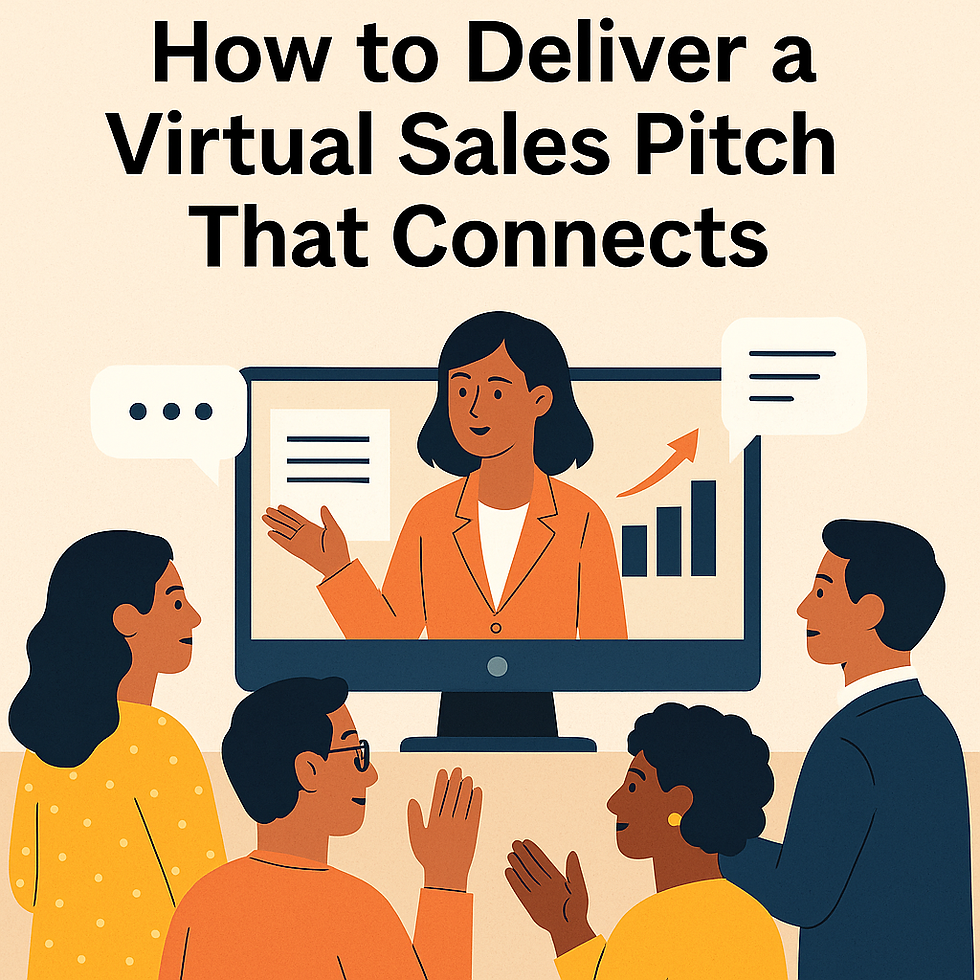Beyond the Slides: How to Craft Virtual Presentations That Actually Win Deals
- Angel Francesca
- Jul 7
- 4 min read
Updated: Sep 16
Let’s be honest. How many times have you watched a virtual sales pitch from one of your own team members and felt your attention drift? You see them talking, the slides are changing, but there’s no energy. No connection. Now imagine how your potential client feels.

In this new world of remote work, the virtual presentation has become the most critical moment in the sales cycle. Yet, many sales teams are simply taking their old in-person pitch and delivering it through a webcam, wondering why results are falling flat. A weak virtual pitch doesn’t just bore an audience; it can erode trust and cost you valuable deals.
For business and sales leaders, the challenge is clear: how do you equip your team to move beyond just talking at a screen and start creating conversations that connect, persuade, and convert? This guide will show you how.
Why Most Virtual Pitches Fail to Connect
Before we get to the solution, we need to understand the problem. Virtual presentations operate under a different set of rules.
The Attention Deficit: You're not just competing for your prospect's attention; you're competing with their inbox, their chat notifications, and the general chaos of a home office. If you don't grab them in the first few minutes, you've lost them.
The Trust Gap: Without the benefit of a handshake and shared physical space, building rapport is much harder. A flat, one-way presentation feels impersonal and makes it difficult for a client to feel a genuine connection with your brand.
Technology as a Barrier: Poor audio, lagging video, or overly complex slides can completely derail a pitch. Instead of focusing on your message, the client is distracted and frustrated by the delivery.
A Framework for Presentations That Persuade
To overcome these hurdles, your team needs a structured approach. It’s not about having the flashiest slides; it’s about mastering the art of virtual communication.
1. Start with a Story, Not a Spec Sheet
The most effective way to capture attention is to tell a compelling story. Don't open with your company history or a list of features.
Real-World Tip: Begin with a short, relatable story about a problem a past client faced—a problem your current prospect likely shares. For example, "When we first met Company X, their team was spending 10 hours a week manually compiling reports. They were frustrated and knew there had to be a better way." This immediately makes the conversation about them, not you.
2. Design for Clarity, Not Complexity
Your visuals should support your message, not become the entire message. Overloaded slides are a primary cause of disengagement.
How to do it: Use visually appealing slides with minimal text. A single powerful image or a single statistic is far more effective than a paragraph of bullet points. As a rule of thumb, if your audience can't grasp the point of your slide in five seconds, it's too complicated.
3. Turn a Monologue into a Dialogue
The single biggest mistake in virtual selling is talking at the audience. The goal is to talk with them. Interaction is your most powerful tool for maintaining engagement.
Case Study: A software firm transformed its weekly demos by incorporating two simple polls. The first, near the beginning, asked, "Which of these challenges is your top priority right now?" This allowed the presenter to tailor the rest of the demo on the fly. The second, near the end, asked, "Which feature you saw today would have the biggest immediate impact on your work?" This created a natural starting point for the closing conversation.
4. Master Your On-Camera Presence
How your team presents themselves is just as important as what they say. Confidence and enthusiasm are contagious, even through a screen.
Pro Tip: Coach your team on the small things: looking directly into the camera lens to simulate eye contact, using vocal variety to avoid a monotone delivery, and ensuring their background is professional and free from distractions. Practising their pitch isn't just about memorising lines; it's about getting comfortable with their virtual delivery.
Give Your Team the Skills to Succeed
Training your team in these techniques can be the difference between a quarter of missed targets and one of record growth. It requires a dedicated effort to build new habits.
This is precisely why we designed the Remote Selling Mastery (RSM) course at ClickAcademy Asia. It provides a complete framework to help your sales professionals excel in today's virtual-first environment. In this course, we teach your team how to:
Structure high-impact narratives that resonate with clients.
Facilitate interactive conversations instead of delivering one-way pitches.
Use visual aids and vocal techniques to project confidence and build trust.
Handle objections and close deals with conviction in a remote setting.
Don’t Just Present—Persuade.
Your best pitch doesn’t belong in a boardroom—it needs to thrive in a browser. The Remote Selling Mastery (RSM) course at ClickAcademy Asia helps your team evolve from webcam fatigue to confident virtual storytelling.
Learn how to engage distracted audiences, build trust through a screen, and turn one-sided presentations into conversations that convert.
Because if you can’t connect virtually, you can’t close virtually. Enrol now. https://www.clickacademyasia.com/course/remote-selling-mastery



Comments